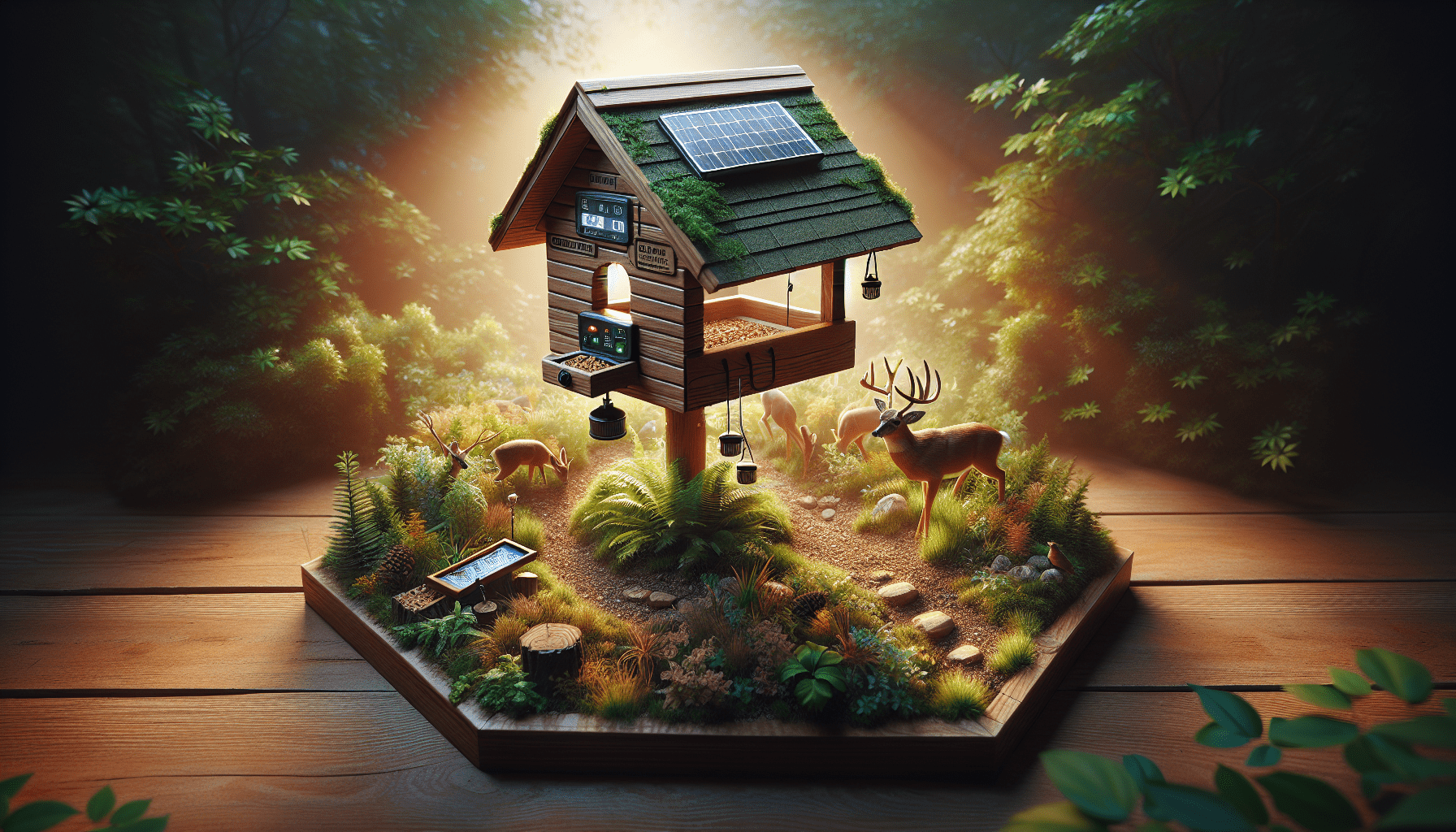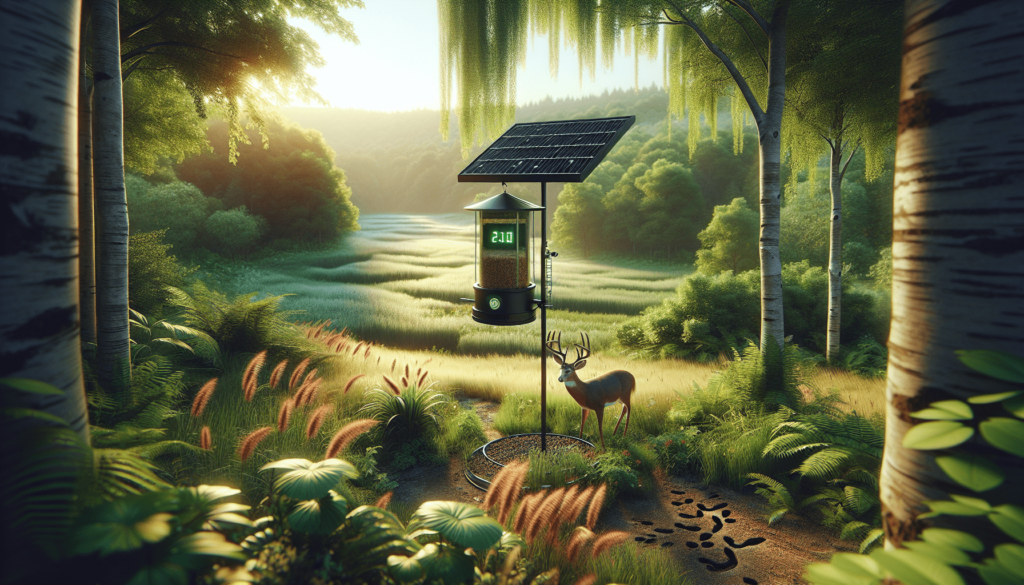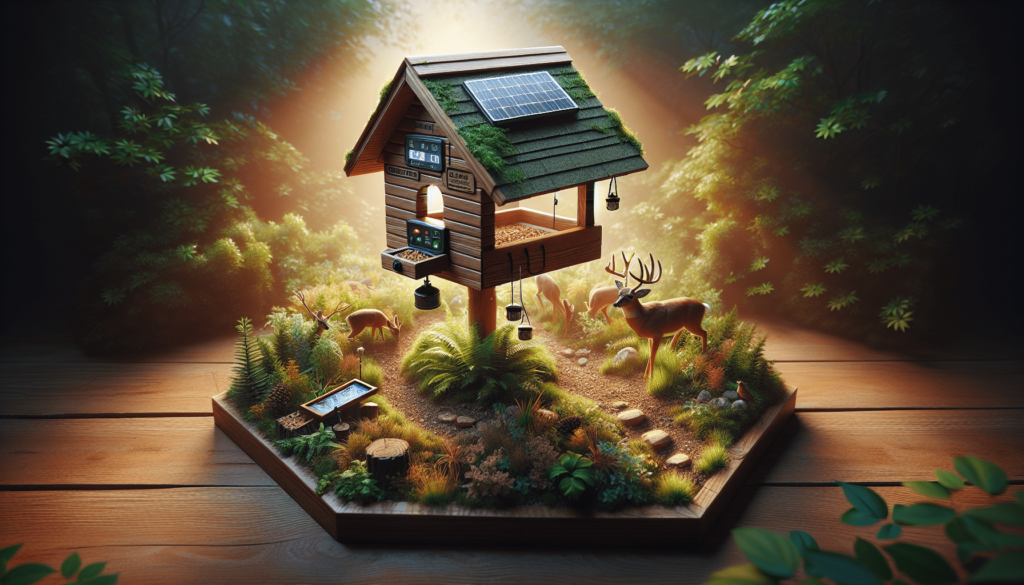
Have you ever thought about how to make your deer feeding setup more efficient and enjoyable? Understanding the essentials of deer feeder accessories can significantly enhance your experience, ensuring that your feeders are functional and attracting deer effectively. Let’s take a closer look at some key accessories, such as timers, solar panels, and more that will support your efforts in wildlife feeding.

The Importance of Deer Feeders
Feeding deer has become a popular outdoor activity, especially for those who enjoy wildlife observation or hunting. The right accessories play a crucial role not only in keeping the feeders operational but also in attracting deer to your designated feeding area.
Deer feeders help to supplement natural food sources, especially in areas where food might be scarce. Ensuring your feeder is equipped with the right tools can enhance its effectiveness, making your feeding experience more rewarding.
Why Upgrade Your Deer Feeder?
So, why should you consider upgrading your deer feeder with accessories? Well, incorporating the right tools can lead to increased efficiency, convenience, and a noticeable uptick in deer visits. A well-equipped feeder allows you to manage feeding times and maintain a consistent feed schedule, which is essential for attracting deer consistently.
Sometimes, all it takes is a few adjustments and enhancements to make your feeding sessions successful. Let’s investigate the essential accessories that will transform your feeding experience.
Timers: Control the Feeding Schedule
Why Use a Timer?
Timers are among the most valuable accessories for your deer feeder. They allow you to control when your feeder dispenses food, ensuring that the feed is available at the right time. This is especially important for maintaining deer activity in your area.
By feeding at specific times, you can train the deer to visit during those hours, making your observations more predictable. Whether you’re interested in wildlife watching or hunting, having the ability to schedule feeding times is a game-changer.
Types of Timers
There are different types of timers you can consider for your feeder. Here’s a simplified overview:
| Timer Type | Description |
|---|---|
| Digital Timers | These allow for precise scheduling and often come with programmable options. You can set multiple feeding times throughout the day. |
| Mechanical Timers | A more straightforward option, these timers work without batteries and can provide reliable functioning even in less-than-ideal weather. |
| Solar-Powered Timers | These timers have the advantage of using solar power, making them an eco-friendly choice that performs well in remote areas with no electricity. |
Each type has its pros and cons. For example, digital timers can offer you more flexibility, while mechanical ones are often more reliable in extreme weather.
Setting Up Your Timer
Setting up a timer might seem daunting, but it’s quite straightforward. Here’s a basic guide to help you:
- Read the Manual: Start with the timer’s manual for specific setup instructions.
- Install Batteries (if applicable): Ensure that any necessary batteries are installed.
- Program Your Schedule: Use the timer’s interface to set your preferred feeding times. Most digital timers allow you to set multiple times throughout the day.
- Attach to the Feeder: Secure the timer to your feeder as instructed. Proper placement is key to effective operation.
- Test Functionality: Run a few tests to ensure the timer activates and dispenses food correctly.
By following these steps, you can easily integrate a timer into your deer feeding routine.
Solar Panels: Powering Your Feeding System
Benefits of Solar Panels
Solar panels are fantastic accessories for deer feeders, especially if you’re looking to reduce reliance on traditional power sources. They offer numerous benefits, including sustainability and cost-efficiency. You can harness the power of the sun to keep your feeder running, which is particularly valuable in remote locations.
Using solar energy can help you manage the operational costs associated with your feeding system. Plus, it can ensure that your feeder continues to function even during extended power outages, which can happen in rural areas.
Choosing the Right Solar Panel
When selecting a solar panel for your deer feeder, consider the following factors:
- Wattage Capacity: Make sure the solar panel has sufficient wattage to power all your feeder accessories.
- Size: The panel should fit well with your feeder, ensuring optimal sunlight exposure.
- Durability: Select weather-resistant models to withstand the elements and provide long-lasting service.
| Feature | Ideal Specification |
|---|---|
| Wattage | 10-20 watts for standard feeders |
| Material | Weather-resistant, sturdy build |
| Size | Compact design, adaptable to feeder size |
Feeders with Built-In Storage
Advantages of Built-In Storage
One innovative feature to consider is a deer feeder with built-in storage. These feeders have a compartment where feed can be stored, ensuring a steady supply without the need for frequent refilling.
Built-in storage enhances convenience and efficiency, allowing you to both feed deer and monitor the feeder without needing to make multiple trips. Additionally, it can help protect feed from moisture and wildlife, keeping it fresh and ready for the deer.
Selecting the Right Feeder
When looking for a deer feeder with built-in storage, pay attention to:
- Feed Capacity: Ensure that the storage can hold enough feed for your needs.
- Ease of Access: Look for designs that allow for easy filling and cleaning.
- Durability: Choose a model made from sturdy materials that can withstand the outdoor environment.
| Feature | Ideal Specification |
|---|---|
| Capacity | Holds enough for at least a week |
| Access | Easy-fill hatch design |
| Build Material | Metal or heavy-duty plastic |

Quality Feed: The Key to Attracting Deer
Selecting Quality Deer Feed
Choosing the right feed is essential for attracting deer to your feeding area. Quality deer feed will provide essential nutrients that promote health and growth. When shopping for deer feed, consider these factors:
- Nutritional Content: Look for feed high in protein and essential vitamins.
- Flavor: Some deer are attracted to flavored feeds, such as corn or molasses mixes.
- Local Deer Dietary Needs: Research what type of feed is best for your region; deer may require different nutrients based on their local environment.
Types of Deer Feed
Here’s a table to break down common types of deer feed you might consider:
| Feed Type | Description |
|---|---|
| Pellets | High in protein and easy to digest. Great for health. |
| Corn | A popular choice, high in carbohydrates, useful for all stages of deer life. |
| Protein Blocks | Supplementary feeds loaded with vitamins and minerals, attracting deer while providing essential nutrition. |
Game Cameras: Keeping An Eye on Your Feeders
Importance of Game Cameras
Game cameras can be a fun and valuable addition to your deer feeding setup. They allow you to monitor deer activity and see who’s visiting your feeders. With the right camera, you can capture images and videos without disturbing the deer.
Game cameras give you insights into deer behavior, including feeding times and patterns, which helps to fine-tune your feeding schedule more effectively. Plus, they can help you track the health and number of deer in your area.
Selecting a Game Camera
When choosing a game camera, keep these features in mind:
- Resolution: Higher resolution ensures clearer images for identifying deer.
- Trigger Speed: A faster trigger speed means you won’t miss moments, as the camera captures quicker actions.
- Battery Life: Long-lasting battery life will minimize the need for frequent replacements.
| Camera Feature | Ideal Specification |
|---|---|
| Resolution | At least 12 MP for clear images |
| Trigger Speed | Less than 0.5 seconds |
| Battery Type | Long-lasting, preferably rechargeable |
Deer Feeding Accessories: Additional Recommendations
Scent Attractants
In addition to feed, you might consider using scent attractants to lure deer to your area. Scent products can enhance the effectiveness of your feeding strategy by appealing to the deer’s sense of smell.
Choose products that mimic natural scents, like acorns or fruit, and apply them near your feeder for optimal results.
Mineral Sites
Establishing mineral sites near your feeders can also encourage deer to frequent the area. Minerals help replenish nutrients that are vital for deer health. Products containing calcium, phosphorus, and salt can be sprinkled to create a mineral-rich area that deer are drawn to.
Traditional Feeders vs. Gravity Feeders
When exploring freeze options, think about whether you want a traditional feeder or a gravity feeder. Both have their own merits:
| Feeder Type | Advantages |
|---|---|
| Traditional Feeder | Controlled dispensing, easy to set up with timers. |
| Gravity Feeder | Continuous flow of feed, less maintenance required. |
Cover and Protection
Don’t forget about providing cover around your feeding area. Planting shrubs or constructing natural barriers can make the feeding area more appealing. This provides deer with a sense of security, encouraging them to visit.
Maintenance Matters
Regular Clean-Up
Maintaining your deer feeder is essential to provide a safe feeding environment. Removing old feed prevents spoilage that can attract unwanted pests or disease. Make sure to clean your feeders regularly to keep them in good condition.
Check for Wear and Tear
Inspect your accessories routinely, especially components like timers and solar panels, to ensure they are functioning properly. Addressing wear and tear promptly can save you time, money, and frustration down the road.
Conclusion: Create Your Ideal Deer Feeding Setup
Creating your ideal deer feeding setup involves more than just placing a feeder in your yard. With the right accessories, you can enhance your experience and boost your deer visitation rates. So, consider integrating timers, solar panels, and game cameras into your setup, while also focusing on quality feed and proper maintenance.
As you fine-tune your deer feeding strategies, enjoy watching nature unfold right before your eyes. Each of these accessories brings you one step closer to making your feeding experience both enjoyable and effective, fostering a deeper connection with local wildlife.
By investing in these essential accessories and maintaining your feeding setup, you’re not just attracting deer; you’re participating in a rewarding practice that benefits both you and the beautiful creatures around you.





